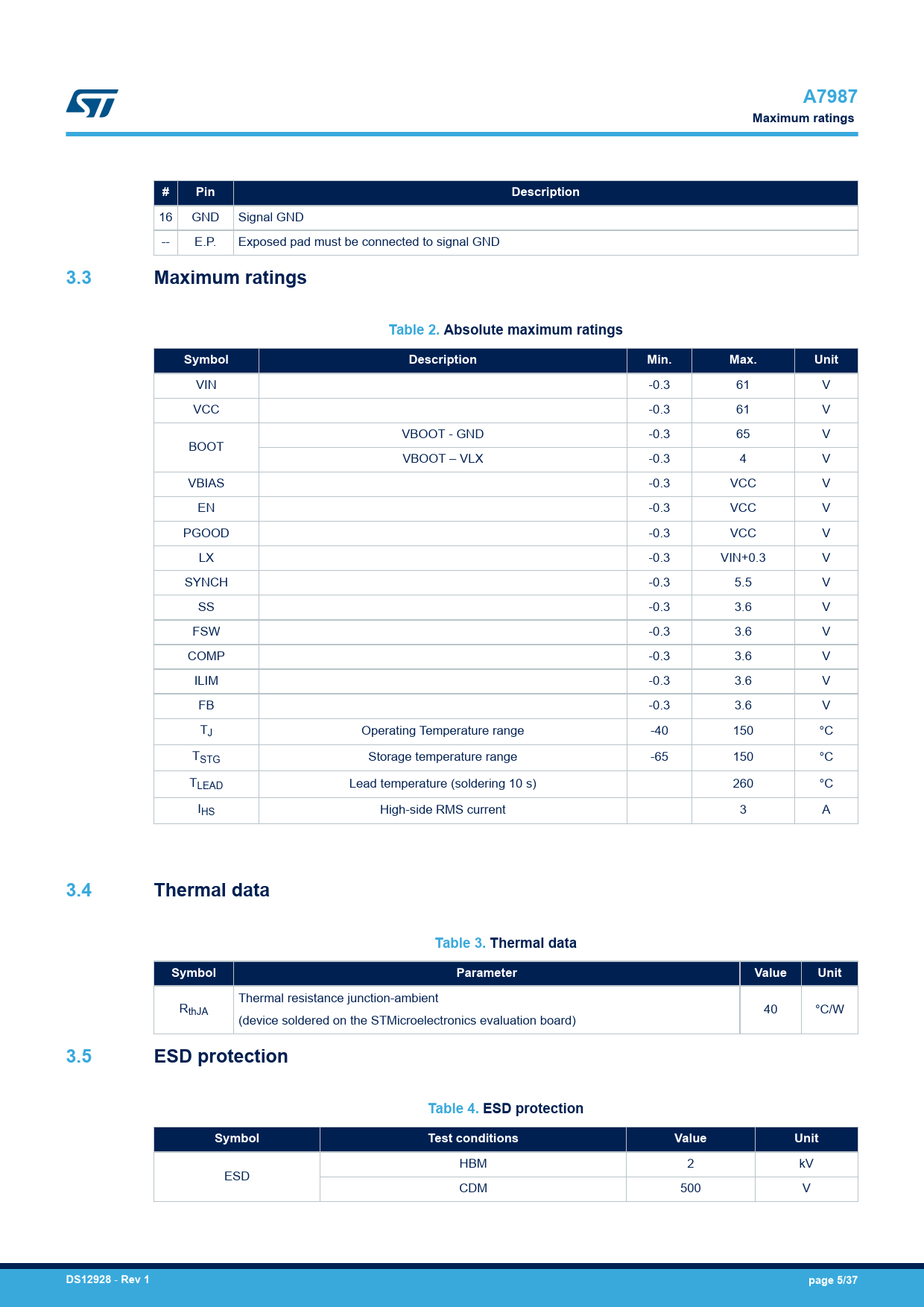Datasheet A7987 (STMicroelectronics) - 5
| Производитель | STMicroelectronics |
| Описание | 61 V 3A asynchronous step-down switching regulator with adjustable current limitation for automotive |
| Страниц / Страница | 37 / 5 — A7987. Maximum ratings. Pin. Description. 3.3. Table 2. Absolute maximum … |
| Формат / Размер файла | PDF / 1.4 Мб |
| Язык документа | английский |
A7987. Maximum ratings. Pin. Description. 3.3. Table 2. Absolute maximum ratings. Symbol. Min. Max. Unit. 3.4. Thermal data

28 предложений от 15 поставщиков 61 V 3A ASYNCHRONOUS STEP-DOWN S. Buck-Boost Regulator Positive Output Step-Down DC-DC Controller IC 16-HTSSOP. PMIC - Voltage Regulators - DC... |
| A7987TR
STMicroelectronics | от 82 ₽ | |
| A7987TR
STMicroelectronics | 464 ₽ | |
| A7987
STMicroelectronics | 505 ₽ | |
| A7987TR
STMicroelectronics | по запросу | |
Модельный ряд для этого даташита
Текстовая версия документа
A7987 Maximum ratings # Pin Description
16 GND Signal GND -- E.P. Exposed pad must be connected to signal GND
3.3 Maximum ratings Table 2. Absolute maximum ratings Symbol Description Min. Max. Unit
VIN -0.3 61 V VCC -0.3 61 V VBOOT - GND -0.3 65 V BOOT VBOOT – VLX -0.3 4 V VBIAS -0.3 VCC V EN -0.3 VCC V PGOOD -0.3 VCC V LX -0.3 VIN+0.3 V SYNCH -0.3 5.5 V SS -0.3 3.6 V FSW -0.3 3.6 V COMP -0.3 3.6 V ILIM -0.3 3.6 V FB -0.3 3.6 V TJ Operating Temperature range -40 150 °C TSTG Storage temperature range -65 150 °C TLEAD Lead temperature (soldering 10 s) 260 °C IHS High-side RMS current 3 A
3.4 Thermal data Table 3. Thermal data Symbol Parameter Value Unit
Thermal resistance junction-ambient RthJA 40 °C/W (device soldered on the STMicroelectronics evaluation board)
3.5 ESD protection Table 4. ESD protection Symbol Test conditions Value Unit
HBM 2 kV ESD CDM 500 V
DS12928
-
Rev 1 page 5/37
Document Outline Cover image Product status link / summary Features Applications Description 1 Application schematic 2 Block diagram 3 Pin settings 3.1 Pin connection 3.2 Pin description 3.3 Maximum ratings 3.4 Thermal data 3.5 ESD protection 4 Electrical characteristics 5 Functional description 5.1 Oscillator and synchronization 5.2 Soft-start 5.3 Error amplifier and light-load management 5.4 Low VIN operation 5.5 Overcurrent protection 5.6 Overtemperature protection 6 Application information 6.1 Input capacitor selection 6.2 Output capacitor selection 6.3 Inductor selection 6.4 Compensation network 6.4.1 Type II compensation network 6.4.2 Type III compensation network 6.5 Thermal considerations 6.6 Layout considerations 7 Demonstration board 8 Application ideas 8.1 Positive buck-boost 8.2 Negative buck-boost 9 Package information 9.1 HTSSOP16 package information 10 Ordering information Revision history
 Купить A7987 на РадиоЛоцман.Цены — от 82 до 648 ₽
Купить A7987 на РадиоЛоцман.Цены — от 82 до 648 ₽